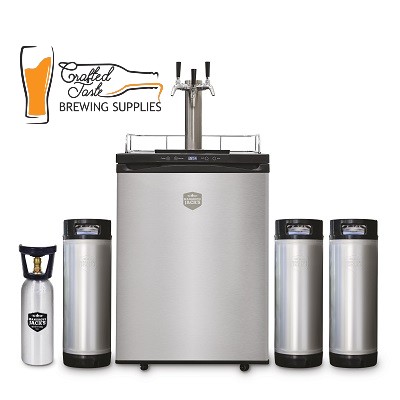
Kegging your beer has many advantages. You no longer need to clean/sanitise bottles, you’re saving valuable time and you’re also reducing additional flavours which are added to your brew through the process of secondary fermentation. Our guide below is going to set out, step by step, the process you can follow to keg your brew. As with everything in Home Brewing, there are several techniques and opinions out there. Our guide on how to keg beer has been used countless times by us and our customers and works a treat.
Step 1 – Clearing or Filtering
Once fermentation is finished it is important to either filter or ‘cold crash’ your brew. Cold crashing is the process of refrigerating a brew to force flocculation of the remaining yeast particles. This ultimately clears your beer as gravity causes them to drop. Rack your brew into a settling cube or secondary vessel and refrigerate for 3 days. Skipping this step will result in increased sediment in the bottom of your keg and a hazy beer.
Step 2 – How to keg beer – Charging
Transfer your brew into a cleaned keg and secure the keg lid. NOTE: YOUR BREW MUST BE COLD TO ADEQUATELY GAS. IF YOUR BREW IS NOT COLD DO NOT CONTINUE TO THE FOLLOWING STEPS UNTIL IT IS CHILLED. When ready to begin gassing your brew, attach the grey gas disconnect on the ‘IN’ post. NOTE: be sure that the disconnect is attached to the correct post as damage to the disconnect can occur when being removed from the incorrect post. Ensure the regulator is wound out, turn the gas on at the gas bottle and wind the regulator until it reaches 30 psi on the low pressure gauge. Charge the keg at 30 psi for 48 hours.
Step 3 – How to keg beer – Dispensing
Turn the gas bottle off after 48 hours, disconnect the gas disconnect and purge the keg. Pull the grey pressure release valve (located on the keg lid) until all pressure has been released and there is no more gas coming from the valve. Wind the regulator back out and release the pressure release valve on the regulator to ensure the low pressure gauge is reading 0 psi. Connect the grey disconnect on the ‘IN’ post and the black disconnect on the ‘OUT’ post. Turn the gas bottle on and slowly wind the regulator in until the low pressure gauge reads between 8-10 psi.
Step 4 – ENJOY!
Your beer is gased and ready to pour.
